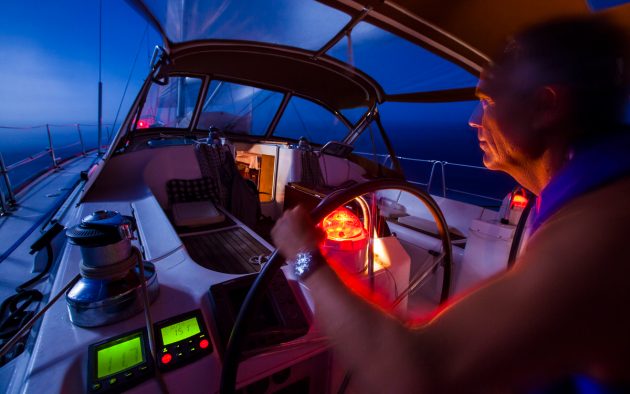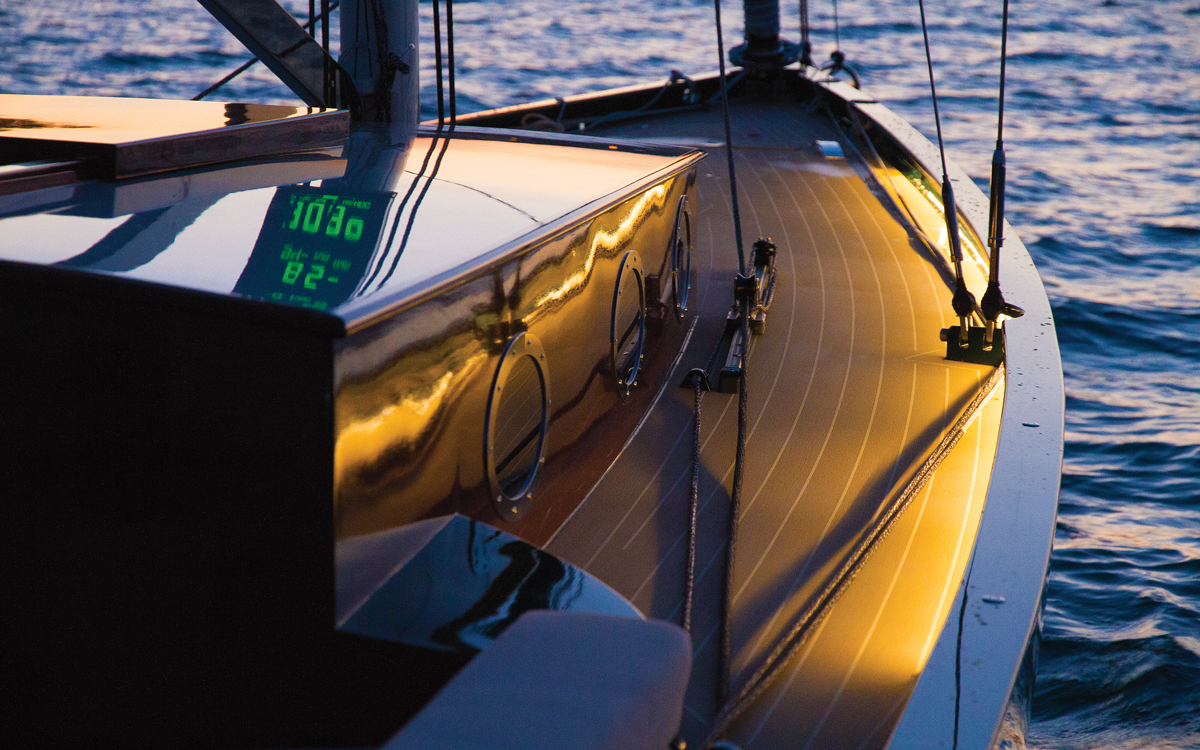Chris Tibbs explains how he uses renewable sources to boost his power options on-board
A cold drink at the end of the day while watching the sun go down is one of the joys of cruising. But the more luxuries we have, the greater the demand for power.
My first transatlantic in 1980 was typical of the time with paraffin lights below, which give a great soft light that doesn’t destroy night vision. We removed the bulb in the heads so it didn’t get left on and it was a challenge to keep the nav lights burning through the night without turning the engine on to charge.
Tinned food was the norm and we didn’t miss the luxuries that have since become standard. However, once we arrived in the Caribbean, chasing around for ice and water became a daily chore and, without a fridge, shopping for fresh food took up a good part of our time.

A cold drink at the end of a long day is well worth the hassle of sourcing or making ice. Photo: Tor Johnson
We have just completed a passage from the UK to Australia in our own 40ft boat. I felt that we had all mod cons with two fridges and a watermaker, but a lot of cruising boats have much more including freezers, ice makers, air conditioning, and even washing machines and dishwashers.
This takes a huge amount of power and the main topic of conversation around various watering holes (after the weather) is all about power management and batteries and how to keep it all running.
Most boats still rely on a 12V or 24V power supply – a form of a lead acid battery, as first invented by Gaston Planté in 1859. Fundamentally it’s a simple equation: we have a store of power in the battery and as long as we put the same in as we take out, all will be well. But this is easier said than done.
Article continues below…
The Dark Transat: how to sail across an ocean after total power failure
A complete power failure mid-ocean is thankfully rare, and it is usually the charging system that fails rather than batteries,…
How hybrid sailing yachts finally became a feasible option
Every sailor is familiar with the wet cough of the diesel engine, and the acrid smell of its exhaust. For…
We spend considerably more of our time in harbour than sailing and harbour can be anything from an anchorage in an uninhabited atoll to a fully serviced marina. So the first question has to be what we want to equip the boat with and where we expect to go.
The further off the beaten track the more self-sufficient we need to be, both in terms of power management and in the facilities we want on board.
Sailing to Australia we wanted to be as self-sufficient as possible and only to switch on the engine for propulsion. We also wanted to use renewable sources as much as possible and to reduce our reliance on diesel.

Although popular with some cruisers solar panels on ‘wings’ seem quite vulnerable
The relationship between amps, volts, and watts is well documented (a great book on the topic is The Boat Electrics Bible by Andy Johnson) and it is easy to work out what expected consumption will be.
We needed to take into account that the ambient temperature is much higher in the Tropics so fridges and freezers would have to work much harder to keep cold and the fridge would be used a lot more.
Charter skippers often complain that guests are always opening the fridge door – each time cold air is replaced by warm. It’s also dark close to 50 per cent of the time, so lighting will be on for longer. Water consumption will be up and, for the lucky few, so is ice consumption.
While we are sailing we have the additional power consumption of chartplotters, computer screens, instruments, and nav lights. As radar is great for squall avoidance it is also often on. With the autopilot often working overtime we can easily be consuming over 20 amps before running a watermaker.

Air conditioning, bow thrusters and stabilisers are all power-hungry items. Photo: Graham Snook
When adding all this together we generally underestimate consumption and therefore the size of battery banks needed and the energy required to charge them.
There is a lot that we can do to reduce consumption: we can change bulbs to LEDs; turn unused screens down or off; spend time hand steering; and be careful using the fridge. But even being as parsimonious as possible, modern cruising still requires a significant amount of power management.
Before we headed off we attempted to estimate our consumption, what battery capacity would be necessary and how we would recharge the batteries. After our electrical audit we estimated that we would consume between 10 and 15 amps per hour.
Using the lower figure this meant 240Ah (amp hours) and, because we would try not to discharge them by more than 50 per cent, would push up our calculated capacity requirements to 360Ah.

Chris and Helen Tibbs’s Centurion 40S, Taistealai. Photo: Paul Wyeth
Then we had to adjust this for reality: a standard alternator will only charge to about 80 per cent of battery capacity, increasing our requirements to 460Ah (360/.8).
Then a further 10 per cent needed adding as the batteries age and become less efficient, pushing the figure to 506Ah. So, for our lower figure of consumption when sailing, a theoretical domestic battery bank of around 500Ah was required.
Sometimes theory and reality clash – changing batteries proved rather more complicated than expected and we ended up with only 420Ah. To have increased the number of batteries or changed to AGM (Absorbent Glass Matt) or gel would have required a considerable amount of carpentry and, in addition to the expense of the batteries, was pushing the budget.
So we knew our capacity was on the low side before we left. So what was the best way of keeping them charged?
As our yacht, Taistealai, (Gaelic for traveller) normally lives on a river we had already fitted 150W of solar panels to keep the batteries full and avoid the need to row out every couple of weeks to run the engine. This was split between the domestic and start battery and worked well.

A hydrogenerator is one option for supplying sustainable power
Our next consideration was whether to fit a diesel generator or not. The advantages are that at a flick of a switch we would have power, which through a modern smart charger would boost the batteries as well as giving AC power.
Watermakers can be AC or DC – the AC models tend to have greater production but depend on a working generator or large inverter. Our boat had no convenient place for a generator and we did not want to be dependent on diesel, so it was an easy decision not to install one. Our choices then were wind, hydro, solar, or fuel cell.
Having used a fuel cell to great effect in the AZAB [the Azores and Back] a few years ago we gave it serious consideration. They are almost fit and forget; when racing we used about 1lt per day of ethanol so cruising would be a bit higher, say 25-30lt for a transatlantic passage.

Photo: Paul Wyeth
However, we felt that although the fuel was becoming more readily available, when sailing across the Pacific it could become more difficult to find. This narrowed our choices to hydro, solar, and wind.
Solar panels are now found on most cruising yachts and vary hugely in quality and price. The main limitations are in available space where they can be mounted without being in shade. We added an extra 80W on the coachroof in the Caribbean, which was the maximum possible without adding large structures to the boat.
Many years ago I delivered a yacht across the Atlantic with a towed hydrogenerator (a propeller on a long rope). At moderate speeds it worked well but too fast and it leapt out of the water, so it had rather put me off. However, the new style hydrogenerators, which look like an outboard motor fastened to the transom, had good reviews.

Hydrogenerators have been used to great affect in the Volvo Ocean Race. Photo: Martin Keruzore
We fitted a Watt & Sea, which provided an abundance of power whenever we were sailing. In the tradewinds when we were sailing quickly (over 7 knots) we found that we only had to use it about 60 per cent of the time to fully charge the batteries. This was the case even when using the small propeller.
Wind was the final piece of the power management jigsaw for us; although rather less efficient when sailing downwind it comes into its own when reaching or in tradewind anchorages when sheltered from the sea behind a reef.
The wind generator really kicked in at between 10-15 knots and combined with the solar panels it met all our needs, including running the watermaker, in many island and atoll anchorages.

Photo: Paul Wyeth
The older wind generators can be noisy but the newer designs are much quieter. The only time we resorted to running the engine to generate electricity was in sheltered anchorages when it was cloudy or raining.
This was our weakness and something that we had not thought through fully. In hindsight we should have fitted a smart charging system to get more out of the main engine alternator and replaced the splitting diodes, which tend to lose about 1V from the alternator, to more sophisticated automatic switches.
On larger boats with a need for AC power, diesel generators make sense and some are remarkably quiet. Regular maintenance and soft starts (not fully loading them at start-up) is said to be key for reliability.
Having the ability to charge from multiple sources adds redundancy to the system and covered us whether sailing or when at anchor.
Using renewables gave quiet and remarkably reliable energy and on smaller boats with limited fuel carrying capacity it removes the need to carry extra cans of fuel. Perhaps we went a little over the top with wind, water, and solar power, but in hindsight it is hard to know which to ditch.
For and against
Diesel generators
+ Instant power
+ Can be used at sea or at anchor
+ Diesel is readily available around the world
+ More efficient than the main engine
+ Available AC power
– Noisy – depends on installation
– Exhaust fumes
– Needs regular servicing
– In the World ARC problems with generators were high on the list of gear failures
– Takes up space
Hydrogenerators
+ Excellent when sailing, particularly on long passages
– Have to stop the boat to lower and raise

Solar panels are often limited by the amount of area out of the shade, especially without adding guardrail panels or a separate hard structure to the yacht. Photo: Paul Wyeth
Solar
+ Fit and forget
+ Effective when leaving the boat
– Shading reduces efficiency – Long nights in the Tropics
Fuel cell
+ Runs quietly with heat and water the only waste
+ Simple installation
+ Small amounts of fuel go a long way
– Fuel may be difficult to obtain in some areas
Wind generators
+ 24-hour power in breeze
+ Great in tradewind anchorages
– Gives limited power when running downwind
– Needs to be mounted above head height






